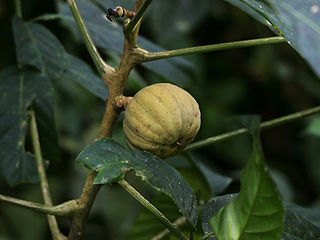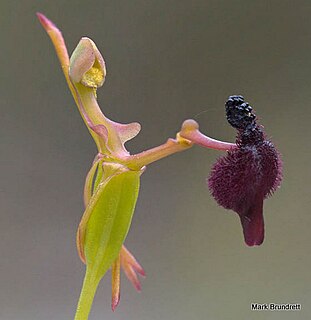
Grammatophyllum speciosum, also called giant orchid, tiger orchid, sugar cane orchid or queen of the orchids, is a species of orchid native to Indonesia. It is listed by the Guinness Book of World Records as the world's tallest orchid, with specimens recorded up to 7.62 metres (25 ft) in height.

Discaria is a genus of 6 species of flowering plants in the family Rhamnaceae, native to temperate regions of the Southern Hemisphere, in Australia, New Zealand and South America.

Hura is a genus of trees in the family Euphorbiaceae described by Carl Linnaeus in 1753. It is native to South America, Mesoamerica, and the West Indies.

Hyaenanche globosa is a species of plant under the family Picrodendraceae. It is the sole member of the genus Hyaenanche and the subtribe Hyaenanchinae. It is endemic to Cape Province in South Africa.

Ariocarpus is a small genus of succulent, subtropical plants of the family Cactaceae.

Schomburgkia is a genus of plants belonging to the family Orchidaceae. This genus is named for Richard Schomburgk, a German botanist who explored British Guiana during the 19th century. Species in this genus are either epiphytic or lithophytic in their growth habit. According to the Royal Horticultural Society Schom. is the official abbreviation for this genus.

Dioscorea oppositifolia is a type of yam (Dioscorea) native to Myanmar (Burma) and to the Indian Subcontinent.

Drakaea is a genus of 10 species in the plant family Orchidaceae commonly known as hammer orchids. All ten species only occur in the south-west of Western Australia. Hammer orchids are characterised by an insectoid labellum that is attached to a narrow, hinged stem, which holds it aloft. The stem can only hinge backwards, where the broadly winged column carries the pollen and stigma. Each species of hammer orchid is pollinated by a specific species of thynnid wasp. Thynnid wasps are unusual in that the female is flightless and mating occurs when the male carries a female away to a source of food. The labellum of the orchid resembles a female thynnid wasp in shape, colour and scent. Insect pollination involving sexual attraction is common in orchids but the interaction between the male thynnid wasp and the hammer orchid is unique in that it involves the insect trying to fly away with a part of the flower.
Bactris major is a small to medium-sized spiny palm which ranges from Mexico, through Central America into northern South America and Trinidad. The species is divided into three or four varieties, although the boundaries between varieties is not always clearly defined.

Chambeyronia macrocarpa is a species of palm tree commonly known as the red leaf palm. It is sometimes called the flamethrower palm. The species is endemic to New Caledonia.

Myrmecophila is a genus of plants belonging to the family Orchidaceae. It is native to southern Mexico, Central America, the West Indies and Venezuela.

Ficinia is a genus of tufted or rhizomatous sedges. There are around 70 recognised species in Africa, three species that occur in New Zealand and a single species Ficinia nodosa that occurs in Australia.

Worsleya is a genus of Brazilian plants in the Amaryllis family, cultivated as an ornamental because of its showy flowers. There is only one known species, Worsleya procera, native to eastern Brazil. It is one of the largest and rarest members of the subfamily Amaryllidoideae.

Dendrobium bigibbum, commonly known as the Cooktown orchid or mauve butterfly orchid, is an epiphytic or lithophytic orchid in the family Orchidaceae. It has cylindrical pseudobulbs, each with between three and five green or purplish leaves and arching flowering stems with up to twenty, usually lilac-purple flowers. It occurs in tropical North Queensland, Australia and New Guinea.

Myrmecophila humboldtii is a species of orchid. The species is named after Alexander von Humboldt. Its natural distribution is from Venezuela and the ABC islands.

Brasiliorchis picta is a species of plant in the orchid family native to Brazil, Paraguay and Argentina.

Dichromanthus michuacanus, the Michoacán lady orchid, is a terrestrial species of orchid. It is common across much of Mexico, the range extending south to Honduras and north into western Texas and southern Arizona.

Agrostistachys indica is a species of plant in the family Euphorbiaceae, known in Singapore as the leaf litter plant. The species is widespread across much of Southeast Asia as well as New Guinea, India, and Sri Lanka.
George Clayton Kennedy (1919–1980) was a professor of geochemistry at UCLA and a botanist with an interest in orchids.

Myrmecophila tibicinis is an orchid in the genus Myrmecophila. A common name for the species is the trumpet player's Schomburgkia. It was first described by Bateman in 1838, as Epidendrum tibicinis., and assigned to the genus. Myrmecophila by Rolfe in 1917.


















